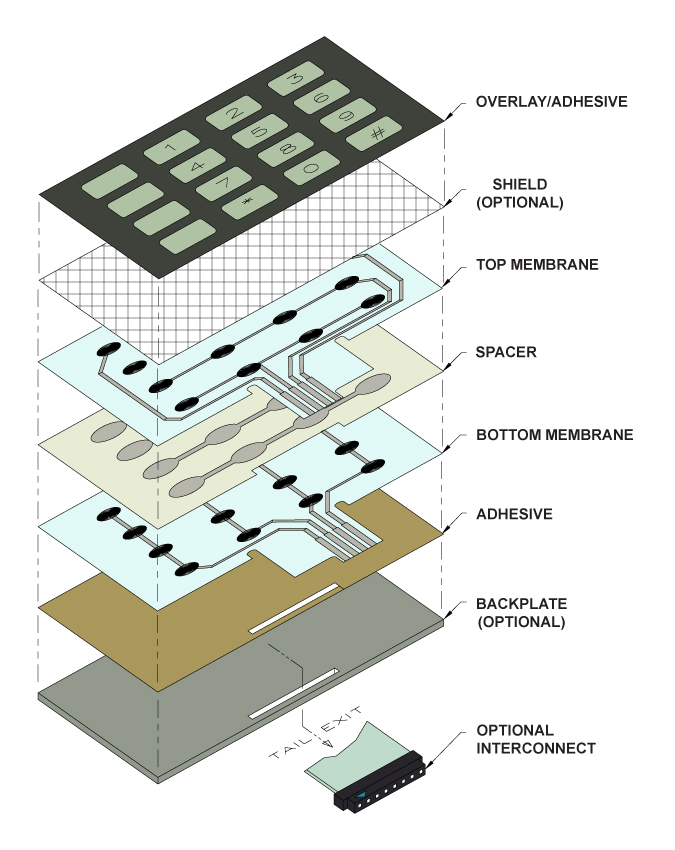Exactly How to Ensure Durability and Integrity with a High-Quality Membrane Switch
Exactly How to Ensure Durability and Integrity with a High-Quality Membrane Switch
Blog Article
Recognizing the Functionality of Membrane Layer Changes for Customer Interface Gadget
The functionality of membrane layer switches stands for a substantial improvement in individual interface design, incorporating efficiency with visual convenience. As sectors increasingly prioritize user experience, understanding the subtleties of membrane layer button technology comes to be important.
What Are Membrane Switches?
Membrane layer switches are innovative interface tools that promote user interaction with digital equipment. These flexible elements include several layers, including a graphic overlay, spacer, and a printed circuit layer. The layout permits for a smooth integration into different digital gadgets, enhancing both the aesthetic and practical aspects of interface.
Membrane switches are typically used in a wide variety of applications, from house appliances to commercial equipment and clinical tools. Their building and construction commonly features a thin profile, making them an excellent choice for small designs. The responsive feedback supplied by these switches can be engineered to meet particular customer preferences, guaranteeing reliable communication in between the user and the tool.
Durability is one more substantial advantage of membrane switches, as they are immune to dirt, wetness, and chemicals, which enhances their life-span sought after environments. Furthermore, these buttons can be customized in terms of shape, dimension, and graphic layout, permitting for branding and user-specific functions. On the whole, membrane changes stand for a functional service for improving user experience in electronic devices, incorporating functionality with visual appeal in a reliable manner.
Exactly How Membrane Layer Switches Work
Operating on an uncomplicated principle, membrane changes use a layered building and construction to register individual input properly. Each button contains multiple layers, including a printed circuit layer, a spacer layer, and a leading visuals layer, which are designed to function together flawlessly. When a customer presses the leading layer, it compresses the spacer layer, bringing the conductive aspects of the circuit layer right into contact with each other.
This call creates a closed circuit, indicating the device to perform a certain function. The style enables numerous arrangements, including tactile feedback, which can improve the customer experience by offering a physical feeling upon activation. The products used in membrane buttons typically consist of adaptable substrates, such as polyester or polycarbonate, which ensure longevity and durability against wear and tear.

Trick Advantages of Membrane Layer Buttons

One more her latest blog significant advantage is their compactness. Membrane switches are slim and lightweight, which allows manufacturers to conserve room in their devices without sacrificing performance. This attribute is especially helpful in applications where weight and quantity are vital factors to consider.
In addition, membrane that site switches are resistant to dirt, wetness, and chemicals, enhancing their durability. This resilience prolongs their life expectancy and reduces the demand for frequent substitutes, causing expense financial savings over time.
Furthermore, the responsive responses given by membrane switches can be enhanced to boost individual interaction. They can include functions such as raised buttons or distinct clicks, improving usability and individual experience.
Applications Throughout Industries
Interface devices using membrane layer buttons prevail in a wide array of industries, showcasing their flexibility and capability. Membrane Switch. In the clinical field, membrane layer buttons are essential to devices such as analysis tools and person tracking systems, where their resilience and simplicity of cleansing are critical for keeping health standards. In the vehicle market, these buttons are used in control panel controls and infotainment systems, giving a smooth and modern-day interface for users.
Furthermore, the customer electronics field gain from membrane switches in devices and handheld gadgets, where compact style and straightforward user interfaces click to find out more improve user experience. Industrial applications likewise take advantage of membrane layer changes for control panels in equipment and automation systems, highlighting their toughness and resistance to harsh environments.
In the aerospace and protection sectors, membrane layer switches are made use of in cockpit controls and tools, where dependability and efficiency under extreme conditions are extremely important. In addition, the video gaming sector increasingly incorporates membrane layer buttons in controllers and game devices, adding to an interesting customer experience. Generally, the convenience of membrane switches over enables their prevalent use throughout various sectors, underscoring their significance in contemporary interface design.
Future Fads in Membrane Layer Switch Modern Technology

Furthermore, making use of advanced products, such as polycarbonate and polyester films, is expected to increase, providing improved resilience and resistance to environmental stressors. These products add to the overall longevity of membrane layer switches, making them appropriate for harsher industrial applications.
Moreover, the incorporation of smart innovation, including IoT connectivity, will certainly make it possible for membrane layer buttons to connect with various other tools and systems, promoting a more interactive customer experience. This trend straightens with the growing need for clever tools throughout various markets, from healthcare to customer electronics.
Lastly, personalization options are anticipated to expand, permitting makers to produce bespoke options tailored to details customer needs and preferences. These advancements will certainly place membrane layer switches as crucial parts in the evolution of interface technology.
Conclusion
Finally, membrane switches over stand for a critical development in interface technology, offering a trustworthy and functional remedy for varied digital applications. Their layered construction assists in compact style, while attributes such as responsive responses improve customer interaction. The longevity against environmental aspects further solidifies their utility throughout numerous sectors. As improvements in material scientific research and touch picking up technologies proceed, the functionality and applicability of membrane switches are anticipated to broaden, strengthening their significance in contemporary electronic tools.
Report this page